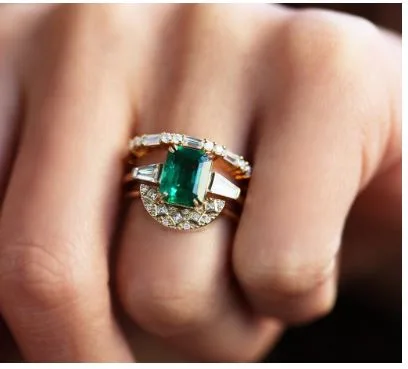Emerald Engagement Rings: Understanding the Difference Between the Emerald Stone and the Emerald Cut
Emerald engagement rings feel rich and alive. The green stone has long been linked with love and renewal. The “emerald cut” is also famous for its clean, elegant look. People often confuse the two because they share a name. An emerald is the gemstone. An emerald cut is the shape of a stone, and it can be used for many gems. Knowing the difference helps when you pick a ring that suits your taste and daily life.
The Emerald Stone
Emerald is a precious gem from the beryl family, like aquamarine and morganite. Its green color comes from tiny amounts of chromium and vanadium inside the crystal. The shade can be light or deep, but the best stones seem to glow.
What many people love about emeralds is their character. Most have small internal patterns called inclusions, often nicknamed “jardin,” which means garden. These are natural and give the stone a unique look. They show that the gem came from the earth, not a factory line.
Emeralds are a bit softer than diamonds or sapphires. On the Mohs scale, they sit around 7.5 to 8, so a hard knock can chip them. That does not make them weak. They just need normal care. If you look after an emerald, it can be worn for years and passed on.
Emeralds also carry meaning. People connect them with rebirth, love, and calm energy. Many couples choose them because they feel elegant without trying too hard.
The Emerald Cut
The emerald cut is a shape, not a gem. Jewelers use it for diamonds, moissanite, sapphires, quartz, and, of course, emeralds. It is usually rectangular with trimmed corners. The long, step-like facets create a hall-of-mirrors look. It does not throw off lots of sparkle like a brilliant cut. It focuses on clear reflections and clean lines.
This shape was first used to protect emeralds during cutting, since their structure benefits from less stress. Over time, people noticed it looked great on other stones, and it became a classic for engagement rings.
Emerald cuts show light in long flashes rather than glitter. The look is calm and refined. It often appeals to someone who likes minimal style. It can also make the finger look longer.
Because the top is so open, clarity matters more with this cut. Inclusions are easier to see than in round or cushion shapes. That is why high-clarity stones like moissanite or lab-grown diamonds look great in emerald cuts. Natural emeralds still look beautiful here too, since their inclusions are part of their charm.
Emerald Stone vs. Emerald Cut: What’s the Difference?
The emerald stone is the material. The emerald cut is the shape. You can have an emerald stone cut round, oval, pear, or emerald cut. You can also have a diamond or moissanite in an emerald cut. When someone says “emerald engagement ring,” they usually mean a ring with an emerald gemstone. “Emerald-cut engagement ring” can mean any gemstone shaped in the emerald-cut style.
Emerald engagement ring set
An emerald ring set pairs the lush green glow of an emerald engagement ring with a matching band that sits flush for a clean, comfortable stack. The emerald symbolizes renewal and love, and its color shines best when the stone is well cut and safely set with fine prongs. Choose 14k or 18k gold or platinum to match your style, then let the contour band add a touch of sparkle without overpowering the center gem. Wear it daily or dress it up for events, and keep it bright with a gentle clean using mild soap, warm water, and a soft brush.
How to choose
It depends on what matters more to you. If you love deep green and the meaning behind it, choose an emerald gemstone. It has warmth and personality that feel unique. If you prefer clean lines, balance, and a calm look, an emerald-cut diamond or moissanite may suit you better.
Shapes and settings for an emerald engagement ring
Emerald gemstones look great in oval and cushion cuts. These shapes can deepen the color and help mask inclusions. The emerald cut is a classic for emeralds too. It shows depth and gives a glassy, refined surface. If you want something softer, a pear or round emerald adds a gentle feel.
For metal, yellow or rose gold brings out the green and gives a vintage or regal mood. White gold and platinum create a cooler, modern contrast that makes the green pop.
Emerald-cut rings, no matter the stone, tend to shine in simple settings. Solitaires, hidden halos, and tapered baguette sides keep the focus on the long, mirror-like facets. The cut loves symmetry, so clean and minimal designs work best.
Why both styles work
Emerald gemstones and emerald cuts come from different ideas, yet both feel timeless and confident. An emerald stone is about color, emotion, and a link to nature. The emerald cut is about precision, grace, and how light moves across flat steps.
You can also combine them. An emerald gemstone in an emerald cut highlights color, texture, and story, while giving it the shape that made the look famous.
Both choices have their own charm. The emerald cut is elegant and versatile. The emerald stone feels alive and meaningful. Whether you love the vivid green of the gem or the calm symmetry of the cut, either choice stands above trends.
Emerald engagement rings are for someone who wants more than sparkle. They speak to detail, symbolism, and authenticity. You might choose an emerald-cut diamond for its refined lines or a natural emerald for its depth and warmth. Both carry a strong, beautiful story.
The emerald stone suggests love that grows and renews. The emerald cut suggests balance and clarity. Either way, your ring becomes more than jewelry. It becomes yours.


